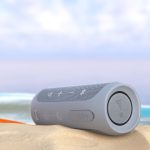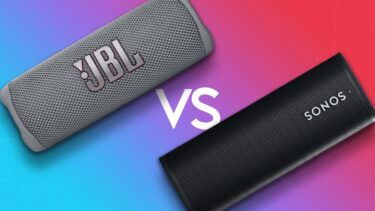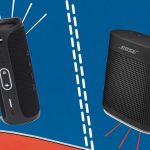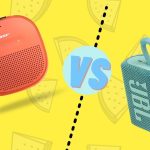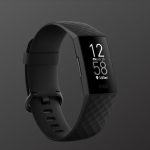Both these speakers have plenty of common features. For example, they are waterproof with a rating of IPX7. It makes them suitable for indoors and outdoors. Secondly, they have a small build and can be carried anywhere without issues. Hence, this brings us to a vital question — which Bluetooth speaker should you buy and why? Well, that’s what we are going to find in this post today as we compare the JBL Pulse 4 with the JBL Charge 4 and see which one is the better deal out of the two. But first,
Looking for a smart soundbar? Here are the best ones with Google Assistant & Amazon AlexaTake a look at these portable Bluetooth speakers with long battery life
Specs That Matter
Design
Let’s start with the design of the older Charge 4. The Charge 4 bears the signature cylindrical look that is common with most portable JBL speakers. The looks are fairly simple, with the passive radiators on the edges and the mid-section bundling a stout build. The buttons are at the top of the device. The good news is that all the buttons are tactile and respond well to touch and press. Interestingly, Charge 4 doesn’t have a Back button. However, for wireless speakers, Charge 4 is a little heavy and weighs almost 3.31 lbs. While ferrying it for a short duration is not a huge issue, it can be problematic to carry it on your hiking adventures or camping trips. In short, the weight undermines the portability of the product. On the upside, it has a rating of IPX7, and it can stay submerged in 1 meter of water for up to 30 minutes. So even if the speaker were to accidentally fall in the water, you’ll get ample time to rescue it. This time JBL has axed the mic functionality in Charge 4. So yeah, you won’t be able to attend to phone calls on the speaker. Thankfully, the 3.5mm headphone jack is still intact. The Pulse 4 also has a cylindrical build and is around 8.5-inches high. This one stands upright, unlike the horizontal setting of Charge 4. As you may have expected, all the buttons are at the top, and the signature passive radiators flank the top and the bottom of the speaker. Quite obviously, there is less of a speaker grille in this one, and the hero is the LED panel at the front. Unlike the previous generation, the LED panel is substantial and covers a huge portion of the speaker. All you need to do is switch the speaker on and see the dance of light and colors. Surely enough, the buttons are responsive and have tactile feedback. Like its counterpart above, this one is also a waterproof speaker and carries a rating of IPX7. Surprisingly, JBL has removed the AUX input and also the microphone to attend hands-free calls. Instead, you’ve an option called PartyBoost which lets you amp up the volume of the speaker by letting you connect to other compatible speakers. Cool, right? Do note that the Pulse 4 doesn’t have a rubber flap over the USB-C charging port at the speaker’s bottom. Should it get submerged or fall into water accidentally, you will have to wait for the water to dry before charging it, and well, it can be a bummer at times.
Battery and Connectivity
The name gives it all out — the JBL Charge 4 is meant to charge. Yes, apart from providing a huge battery backup, you can also use the Charge 4 to well, charge your gadgets like phones and earphones on the go. It is powered by a whopping 7500mAh battery unit (bigger than most flagships, if you ask me). When it comes to music, it can play continuously for around 20 hours before needing a top-up. The best part is that it needs just about 4.5 hours to recharge. Plus, the USB-C charging port means you can also use your phone’s USB-C charging cable to do the needful. Being a generation older, the JBL Charge 4 doesn’t have PartyBoost. Instead, it comes with a feature called JBL Connect+. You can wirelessly link other compatible (maximum 100) JBL speakers to boost the volume levels using that. When it comes to outdoor usage or party scenarios, this is more than a welcome feature. Surely enough, the Pulse 4 has a less run time. On a full charge, it has a playback time of around 12 hours and is backed by a massive 7260mAh battery unit. The charging time is almost similar to Charge 4, and it takes around 4 hours for the battery unit to be replenished. Do note that the LED panel and the volume level will play a heavy part in the battery life of the Pulse 4. Thankfully, there is an option to disable the light show, should you want to extend the battery life.
Sound Performance
Well, to be honest, gimmicks like extra power and LED lights won’t account for long if the speaker in question doesn’t deliver a solid performance. Thankfully, in that sector, both the Pulse 4 and Charge 4 doesn’t disappoint. The JBL Charge 4 packs a 30W driver and delivers solid and balanced audio. The bass is on point, and you get a wider soundstage. Vocals appear clear and even if it’s a song with a high-bass, you will be able to make out the vocals just fine. As opposed to it, the Pulse 4 packs a 20W driver. Even though it has slightly less muscle power, it still manages to deliver a powerful and balanced sound. The good news is that the bass is beautifully balanced despite being a party speaker. The loudness is apt, though the bass seems unresponsive when the volume is cranked up, which isn’t an issue with the Charge 4. Aside from the sound performance, the key highlight of this speaker is its LED panel, which produces gorgeous swirling color in various colors and hues, gives a hypnotic vibe, and livens up the scene around. The best part is that these lights sync with the song.
Light vs. Charge
Well, when it comes to choosing a speaker between JBL Pulse 4 and JBL Charge 4, there’s a difference between night and day. Both the speakers are on the heavy side and thus undermine the portability factor (for long periods). If you are looking for a party speaker that you want to use mainly indoors, the Pulse 4 is the one for you. The loudness is just apt for indoors, and so is the bass. And the LED light panel is just the right addition for it. However, if you want to take it outdoors, the volume can be a tad on the lower side. On the other hand, the JBL Charge 4 is louder and delivers a clear vocal. And the powerful bass should be reason enough for you to buy this product. Plus, you also get the advantage of longer battery life and the power of a portable power bank. The above article may contain affiliate links which help support Guiding Tech. However, it does not affect our editorial integrity. The content remains unbiased and authentic.








